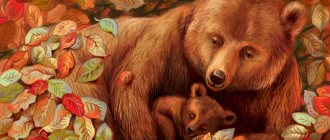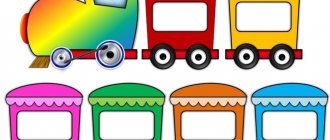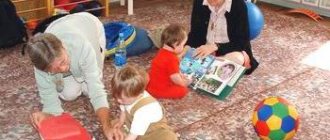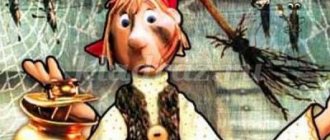Open event in the preparatory group.
Summary of an open lesson for teachers and parents
“Intellectual game “What, where, when?” for children of the preparatory group"
Goal: Consolidation and systematization of knowledge in the sections “Speech Development”, “Acquaintance with the Environment”, “FEMP”.
Objectives: To clarify and activate the vocabulary on the topic “Spring” through a didactic game. Develop coherent speech, improve sound analysis. Train phonemic hearing, come up with words with given sounds, consolidate knowledge about geometric shapes, practice orientation on a sheet of paper, in composing and solving problems. Develop visual attention, perception, memory, creativity, and cultivate interest in the game.
Equipment.
Playing field with a top for the game “What? Where? When?"; envelopes with tasks from the Wise Owl, a musical break and a black box with tasks; presentation on the theme “Spring”.
Screens with numbers. Didactic games: “Seasons”, “Professions”. Medals with children's names. Sound recording of melodies from the TV show “What? Where? When?”, musical game “We are funny monkeys”.
Progress of the game.
Music from the TV show What? Where? When?
- Attention attention! Today in the preparatory group of the Teremok kindergarten the game What? Where? When? The Wise Owl plays against the experts:
- So, we welcome our experts. (Medals are put on). Children say their names. They sit down at the tables."
We are a team of experts
And we know everything in the world.
Ask us questions
We will answer them!”
(The educator represents teachers and parents.)
-Before we start the game, let's do a little warm-up. 1. What time of year is it now?
2. What month?3. What months of spring do you know?4. What are the signs of early spring? 5. What day of the week is it today? 6. What will it be tomorrow? 7. Name the days of the week in order. 8. What holidays do we celebrate in March?
-The right to spin the top is granted to (child’s name). Music is playing. The arrow points to the sector….(envelope number.)
(The teacher opens the envelope, reads the task, the children answer, a flower is given for the correct answer).
-Dear experts, what sounds do you know? What is the difference? Think of words that begin with vowel sounds (use the alphabet).
-Music sounds, the next child spins the top. The arrow points to the sector...(envelope number.)
The wise owl plays against the experts.
-Dear experts, there was some confusion in my game “Seasons”. Look carefully at the pictures, overlay only those where you see signs of early spring, tell us why you chose this particular picture.
-The experts completed the task, well done!
Music sounds, the next child spins the top. The arrow points to the sector (envelope number).
-Dear experts. I have different words. Count how many parts they have and lay them out using chips.
-Well done, you completed the task.
The arrow points to sector no..
Dear experts, I wanted to know if you know poems about spring? - (Children answer). Well done, I think you completed the task (after each correct answer the owl gives the child a flower.)
The Wise Owl and her next task play against the experts (children are asked to draw a circle, oval, square, rectangle, trapezoid, rhombus, triangle in different parts of the sheet with different pencils.) The Owl names the children who completed the task correctly.
The arrow points to the sector. “Musical break” (Musical game “We are funny monkeys.”)
The arrow points to the sector. "Black Box" (music plays)
Dear experts, you need to guess what is in the black box - Now I will tell you a riddle, and you tell me the object lying in the box. (She deftly scooped up the sugar, dived headlong into the cup, stirred the tea a little. Who is she, answer me?
(Spoon). (there are three different spoons in the box. Children name the materials from which they are made.) Then the game continues, the children spin the top 4 times and answer the questions of the Wise Owl. Musical pause. (Song “Grandma.”)
Dear experts, during the game you received flowers for correct answers. Count them. (Children count the flowers, the winner of the game is revealed, the owl gives the children “Coloring Books”, thanks them for the game.)
The event was attended by teachers of the Moscow Secondary School Sazonova E.A. and Pronina M.N.
What? Where? When? A selection of questions from the arts and crafts game
Do you like the game What? Where? When? I've been watching it since childhood, and I thought it would be interesting to make a small selection of questions from What? Where? When? for the Masters Fair. So - “What is our life? - A game!" — questions about needlework, art, crafts, flights of fancy, apt names, trusted suppliers and how to properly return from the fair. 1. In the Altai Republic, during excavations of the Bazaryk mound, dating back to the 6th-5th centuries. BC, among other things, women's shoes were found with pyrite stones attached to the soles. Why were pyrite stones attached to the soles of shoes? (Anna Erelina, Sugash).
Answer from experts: Such a sole did not allow slipping and left an individual mark. Correct answer: In ancient times, an Altai woman squatted before and during rituals. Since the sole was visible, the shiny pyrite stones served as decoration.
2. Unusual stone. This unusual stone was discovered in the 60s of the 20th century and various jewelry began to be made from it. What has led to the fact that in our time these stones are on the verge of extinction?
Answer from experts: Car paint, which was previously applied in layers, is now a different paint or cars are being replaced more often. Correct Answer: Fordite, or Detroit agate (both informal names), is old automobile paint that has hardened enough to be cut and polished. This material was formed by building up layers of enamel paint on the pillars and skids on which cars were painted by hand using sprayers. The layers of paint hardened as the pillars were repeatedly passed through the ovens in which the painted cars were dried. Fordite, named after Henry Ford, has become rare as the car painting process has become automated and waste has been reduced. The experts' answer was found to be incorrect.
3. Attention, Aivazovsky!
Ivan Konstantinovich Aivazovsky named all the dishes that were served at dinner parties in his house in Feodosia after his paintings. What was served to the guests under the title of this painting “From Calm to Hurricane”?
Answer from experts: In the title of the picture the word “dried apricots” is clearly heard, and perhaps it was dried apricots or some kind of dish made from dried apricots that was served
Correct answer: Champagne. 4. In the foyer of the Prague City Library there is a sculpture by the Slovak artist Mattei Kren, which symbolizes the infinity of knowledge. To realize his plan, the author needed 8 thousand objects, or rather 8 thousand and 2 more. What did the artist create his creation from? (Lyudmila and Alexey Kozyrev, Prague, Czech Republic) Correct answer: From books and two mirrors. Two mirrors create the effect of an endless tunnel made of books. The experts answered correctly. Just a dizzying idea!
5. For what carpentry work are axes with curved ax handles used? They are right and left.
Correct answer: For hewing walls. The experts answered incorrectly. 6. List for the Queen.
One day, Queen Elizabeth I of England was brought a list of candidates for the position of sheriff at the very moment when she was engaged in a very important matter. The Queen had to mark one of them, but there was no pen at hand, and she did not want to tear herself away from her important task. What was the queen doing so important and what way did she find to mark the right candidate? (Tatiana Pitchenko, Kharkov, Ukraine) Answer from experts: She marked the name with lipstick while applying makeup. Correct answer: She was doing needlework and, not wanting to tear herself away from it, punctured a hole with a needle opposite the name of the candidate she had chosen. Since then, a tradition has emerged of establishing a sheriff in England, which has been preserved to this day 7. Attention, ashk-dan!
The curved neck prevents evaporation; moisture condenses at the bend and flows back inside. This is not accidental - “ashk”, that is, what was in this container - “dana”, had to be carefully stored. On what occasions did the ancient Persians give this vessel to their wives? How is the word “ashk” translated from Farsi? Boris Burda answers: The ancient Persians gave this vessel to their wives when they left for a long period. It is expected that in the absence of the head of the family, the spouse will miss him and cry, and collect her tears in a teardrop. "Ashk" means "tear" in Farsi.
The experts answered correctly (and very artistically)8. For many years, France supplied Africa with cotton fabrics made in India. At the end of the 18th century, the French began to produce these fabrics in their country at the manufactory in Rouen. But Africans still preferred fabrics from India and easily distinguished them. How did they do it? Correct answer: By smell. From India, fabrics were brought along with various spices, their smell was absorbed by the fabrics. The experts answered correctly.
9. Attention, funny pictures!
Here are photographs of advertising posters for one automobile company. What does this company encourage its clients to do?
Answer from experts: Posters urge not to behave rudely on the roads Correct answer: Posters urge to use original spare parts. 10. If you return from the fair with your pockets full of money, say that you didn’t earn anything, and if you actually didn’t earn anything, say that it was the best fair of your life. With whom did Sholom Aleichem advise to behave this way and why? (Maxim Rylkov, Nizy village). Correct answer: With your neighbors, so that they don’t get jealous and you get satisfaction after an unsuccessful fair. The experts answered correctly.
11. In recent years, custom wedding rings have become popular in Europe. On all such rings the patterns are similar, but not identical. What do the patterns on these rings mean?
Correct answer: These are oscillograms of the recording of the voices of the bride and groom: “agree” and “agree.”
The experts answered correctly. 12. “In order to calmly do my favorite thing, I came up with the idea of using a kettle, otherwise my Vasily will disturb me. Name my hobby." Tatyana Yashchenko (Kyiv, Ukraine)
Correct answer: My hobby is knitting, and my cat Vasily takes the ball and confuses everything. Therefore, I hide the ball in the teapot, thread it through the spout and calmly knit. The experts answered correctly. 13. An unusual bowl is brought into the studio. Behind the scenes we have what it is intended for. What's behind the scenes? (Igor Yanovich, Gomel).
Experts' answer: Fishing bait Correct answer: A ball of thread. It is convenient to knit in this bowl; the ball will not roll out of it. 14. The question was removed by the viewer himself.
“As you can see, I do canvas embroidery. Now tell me, what did the French lexicographer and philosopher Pierre Gouasse compare the reverse side of patterns embroidered on canvas with?” (Natalia Chukreeva, Lipetsk). Correct answer: Literary translation always differs from the original
The experts answered correctly. 15. Smile!
For what purpose were such toys invented? (Anastasia Ivanova, Irkutsk) Answer from experts: Such toys can be hung above the crib so that the child, for example, stretches for this toy. Correct answer: Such toys were invented for photographing children. It is put on the camera lens. The child looks into the lens and smiles. 16. My favorite question, which I still remember 20 years later, was played back in 1997. Unfortunately, I couldn’t find a photo of that masterpiece and you’ll have to give free rein to your imagination! The children’s drawing shows a blue hare with yellow arms and a long tail. What fairy tale did the child read the day before? The answer from the experts. Teremok. Correct answer. The Tale of Tsar Saltan. The queen gave birth that night to either a son or a daughter, not a mouse, not a frog, but an unknown animal. 17. God sculpted man, made everything for him as if it were real. There was also a piece of clay left. God asks a man: “What should you make from this piece of clay?” “Make me,” says the man, “happiness; I have everything else. Only happiness is missing.” What did God do in response to man's request? Correct answer: God gave the man clay and told him to create happiness for himself.
The experts answered correctly.
Thank you for your attention! I wish everyone interesting ideas and their brilliant implementations, successful fairs, and happiness!
How to develop and run your own “What?” game on Zoom. Where? When?"
Everyone knows and remembers, and many may still watch the famous TV show “What? Where? When?". But in fact, such an intellectual game with interesting questions and friendly competition is easy to come up with and play yourself, sitting at home.
What are the advantages of the online format “What? Where? When?"
1.
A great way to spend an active, intellectual evening, meet with friends and acquaintances online. Together we will learn a lot of new and interesting things in a variety of areas.
2.
You can play at any convenient time with any number of players without leaving your home.
3.
You can play for children, adults and even the whole family.
4.
An excellent option for an extra-curricular online event at school, you can unite, not get bored and get a boost of good mood (note to teachers and class teachers :))
How to come up with questions for the game “What? Where? When?"?
On a real TV show, sometimes such interesting and difficult questions arise. Where do TV viewers get them from? I'm revealing secrets :))
1.
Type in the search engine “The most interesting facts about...” or “Interesting articles about...”, and then write the topic on which you would like to ask or to which you would like to dedicate the game. The topic can be absolutely anything (nature, animals, history, art, sights, different countries, traditions of the peoples of the world, etc.), interesting facts can be found in all areas.
For example, I requested: “Interesting facts about the Leaning Tower of Pisa”
2.
Browse all the sites in a row and copy into a separate text file all the facts that seemed interesting and unusual to you. It is better if this is information that few people know. Believe me, you will get enough options, it won’t take much time.
I especially recommend the sites: https://pustunchik.ua/ (Section “Virtual School”) and https://azbyka.ru/deti/logicheskie-i-zanimatelnye-zadachi, as well as the series of TV shows “Records of my planet” (with Andrey Ponkratov and Timofey Bazhenov).
3.
Next, select the most interesting facts from everything copied, and delete the rest. When choosing, take into account the age of the players (for adults, the fact about the fairy tale “Kolobok” will not be very relevant, and younger students are unlikely to understand the fact about organic chemistry). It is better that the information is of varying complexity, so that there are simple facts, but complex ones also remain; from them, as a rule, you can create a more interesting question.
For example, I found the fact: “On the bell tower of the Leaning Tower of Pisa there are 7 bells, each of which is tuned to its own specific note.”
4.
Now you need to formulate questions from the selected facts. Questions should be formulated in such a way that a person can answer them using logical reasoning or using his normal outlook without special training (therefore, the question “What is the oxidation state of chlorine in hydrochloric acid?” is not suitable). It is important that information is given before the question, on the basis of which players can build a chain of logical reasoning or make their guesses. It is important that the question itself is formulated clearly and understandably for everyone; to do this, use question words (“when”, “why”, “what”, “why”, “which”, “how much”, etc.). The question should be interesting so that when answering it people will learn new interesting and useful facts.
Put yourself in the shoes of the players, imagine that you are answering this question without knowing the fact itself. What guesses would you make then? Is additional information needed to answer? Is there even a chance to answer this question logically? Then think in advance and write down the correct answer.
For example:
Question: “There are 7 bells on the bell tower of the Leaning Tower of Pisa. Why exactly this number of bells are located on the bell tower of the tower?”
Correct answer: “Each bell in the bell tower of the Leaning Tower of Pisa plays one of seven notes.”
Possible guesses from the players: “The tower couldn’t fit more bells”; “It has something to do with the mystical nature of this number”; “Maybe the tower only has seven floors, and each floor has one bell.”
5.
You should not do less than 12 or more than 25 questions.
It is best if there are different types of questions in the game.
a) A common question.
It's in the text.
As a rule, it is of medium or increased difficulty. (How to come up with it, see above)
b) “Black box” question.
This is an ordinary question of average or increased difficulty based on the text, but the answer must contain one word-subject. The item must be placed in the Black Box in advance, and shown to the players when checking the answers.
For example: “The Great Wall of China is one of the most ancient architectural monuments. It was built back in the 3rd century BC. But most of the wall has survived to this day. It turns out that the reason for this is a secret ingredient that the Chinese used to smear the stones. What is this ingredient? He is now in the Black Box." (Answer: This is rice, it is what is in the Black Box)
c) Flash question.
One question, consisting of 3 simple short questions, which are given less time in the game and are easy to find the answer to.
(You can come up with it the same way as a regular question).
For example: “Which animal, according to O. Henry, is constantly driven into with nails?” (Answer: Horse (it is shoed)).
d) Question about the picture.
This is a question in which players are given a picture and an explanation for it. Using the picture, players must make guesses and give an answer. The pictures can be anything, but they must be related to some interesting fact.
For example: “Look at the picture (see photo above). This happened in the USA at the beginning of the 20th century. What do these people do? What are they doing?" (Answer: These people are postmen. In the early 20th century, children were often sent through the mail in the United States.)
e) Video question.
First, players watch a short (no longer than 3 minutes) video, then explanations are given and a question is asked about the video, players answer this question using the information shown in the video. The question must be related to the video. The video should be interesting and should contain an interesting fact.
For example: “You watched a short video (see above). Thanks to this cartoon, the authors wanted to wean many people from the habit of eating something harmful. What food are the authors of the video against? (Answer: The authors of the video turned the audience against fast food, the animals ate it, that’s why they are so fat and cannot live well).
f) Audio question.
First, players listen to a short melody or song. Then an explanation is given to it, and according to this melody the players must answer the question. The melody should be associated with some interesting and unusual fact.
For example: “Listen to an excerpt from a famous song (audio recording sounds). What kind of song do you think this is? What language is it performed in? (Answer: This is the song “Katyusha” in Chinese).
What else do you need when preparing for the game?
1.
Create a PowerPoint presentation that you will show on Zoom. The first slide is the splash screen. The second slide is the rules of the game. Next, 2 slides for each question: on the first slide the question itself, on the second - the correct answer to it. The presentation must include all necessary pictures, video and audio. If the game is played for children, it is better to accompany each question with a picture, this will make it more interesting for the children. Don't forget that the questions on the slide should be visible and readable (watch the color and font size).
2.
Count the approximate number of teams (it is better if there are from 3 to 10). Make cards with team numbers (just write the numbers) and put them in the box.
3.
Send invitations to all players for a specific day and time, with a Zoom conference ID and password.
How to play the game “What? Where? When?"?
1.
Teams gather in a Zoom conference. Ask all players to turn on video communication and turn off microphones. Microphones can be turned on by a team that, at the request of the presenter, answers a question; during the discussion, the microphones must be turned off. This is extremely important, otherwise the event will fail! Explain the rules of the game to the teams. Give each team its own number, the team must remember it and respond to it.
2.
The presenter reads the question, then the question appears on the screen (in presentation mode in Zoom).
3.
Teams are given 40 seconds (20 seconds for flash questions) to think and jointly search for an answer. You cannot use the Internet or reference books, otherwise the game will not be fair and interesting.
4.
The presenter at random (as in the game “Forfeits”) takes the team number out of the box. This command turns on the microphone and answers the question. If a team answers incorrectly, the other team answers. Players can make assumptions and guesses. The presenter can answer them “yes”, “no”, “close” or give small hints. The presenter then sets aside the number of that team and takes out the next number. When all the numbers are over, you can take them out in a new circle.
5.
For the correct answer, the team receives points (simple question - 1 point, complex question - 2 points, quick questions - 0.5 points). The presenter writes down the points on a special piece of paper.
6.
At the end of the game, the points are tallied. The presenter announces the places. The team with the most points wins.
Remember all the technical aspects of playing in Zoom
1.
Players' video is always on, microphones are only on when answering.
2.
A basic Zoom conference lasts 40 minutes; before the end of the conference, ask all players to reconnect in advance. But in principle, it’s not worth playing for more than 60 minutes, otherwise everyone will get tired and interest will disappear. Therefore, plan your time.
3.
Observe the signals, actions and reactions of all teams; to do this, scroll through the “windows” with the video.
4.
Ensure a stable Internet connection, otherwise the conference will be interrupted.
5.
In Zoom, when sharing your screen, your presentation can sometimes freeze and get stuck on one slide. If this happens, ask the players to tell you about it and restart the screenshare.
That's all the secrets :))
It's actually not as difficult as it seems. You just need to try it!
I am sure you will definitely be able to give a good mood and interesting and useful knowledge to your friends and acquaintances.
I wish you success!!!
© Ekaterina Khasanova








